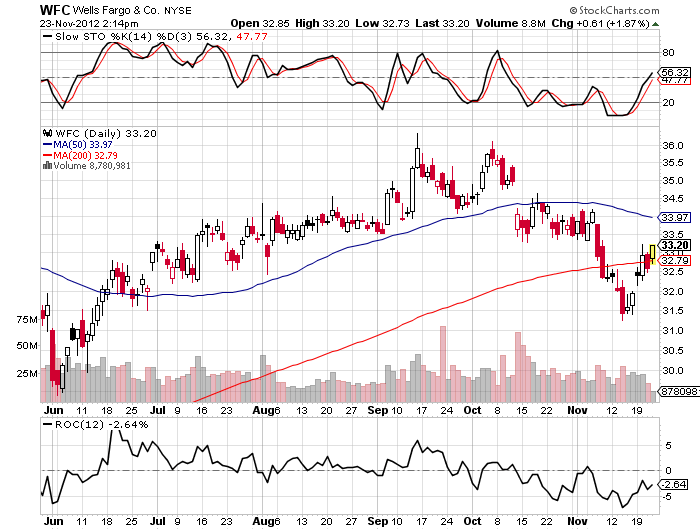Before I discuss the fiscal cliff it is important to discuss the current state of the market for common equity shares of Wells Fargo (WFC). The share price of Wells Fargo is trending lower.
The firm is showing average relative strength during this corrective wave and the share price is expected to continue to decline. A catalyst for the decline is the fiscal cliff.
Market participants are expressing some concern over potential U.S. federal government expenditure cuts and revenue increases of more than $600 billion set to take effect in 2013.
Without the fiscal cliff I project a deficit of about $960 billion. Outlays are forecasted to be little changed from the 2012 level, and receipts are forecasted to increase to about $2.59 trillion.
With the fiscal cliff I project a budget deficit of about $850 billion. Outlays decline but receipts also decline as the impact of the decreased government expenditure decreases federal revenue.
Under a third assumption about $200 billion of fiscal cliff takes effect in 2013. Most of the cuts come from reductions in outlays and the budget deficit is roughly $838 billion.
Without the fiscal cliff U.S. economic growth is roughly 2 percent. With the fiscal cliff U.S. growth is negative in 2013. With a mild fiscal cliff U.S. growth is slightly slower than under the no fiscal cliff scenario.
Further, Republican leadership expressed a desire not to increase tax rates without tax-code reform. The leaders of the Democrat party believe taxes on the wealthy should increase. I don't think tax-code reform is going to happen in a month.
Thus, the most likely outcome, in my opinion, of the federal budget debate is to maintain current fiscal outlay levels. My preferred outcome is a slight reduction in fiscal 2013 outlays compared to fiscal 2012. The decline may come in current-dollar terms or real-dollar terms.
In October, the first month of fiscal 2013, the budget deficit was about $120 billion. The year-to-date deficit was larger than 2012's as outlays increased faster than receipts. The fiscal deficit for 2013 is projected to be about $990.6 billion, according to the Office of Management and Budget. As previously stated, without changes to current legislation I project a budget deficit of $960.9 billion.
Current-dollar GDP was roughly $15.78 trillion in 2012's third quarter. The revenue increases and spending cuts from the fiscal cliff are about 4 percent of GDP.
Apply a multiplier of 1.3 the fiscal cliff would be about 5.2 percent of GDP. Please note, the multiplier of 1.3 is an estimate. In other words, the cliff is quite steep.
Under the scenario without the fiscal cliff shares of Wells Fargo return 20-30 percent next year. The fiscal cliff scenario suggests a return of about negative 20-30 percent next year. Finally, the scenario with a $200 billion reduction in federal expenditure suggests shares of Wells Fargo should return 10-20 percent in 2013.
All of the return assumptions and deficit projections are subject to revision as new information is added to financial models.
Financial Analysis
Net interest income from the bank has been declining in recent years and could continue to decline this year. However, net income is increasing and is on pace to continue to increase this year compared to last year.
Revenue from community banking declined in 2012's third compared to the year-ago quarter and the second quarter. Revenue was $7.24 billion in the third quarter, $7.31 billion in the second quarter, and $7.27 billion in the year-ago quarter. Community banking revenue is trending lower.
Wholesale banking revenue is trending higher. That said, revenue declined sequentially and increased compared to the year-ago quarter. Revenue in the third quarter was $3.03 billion. Revenue in the second quarter was $3.35 billion.
Wealth, brokerage and retirement revenue is trending higher. That said, revenue declined compared to the year-ago quarter and the second quarter. Revenue in the third quarter was $680. Revenue in the second quarter was $698 million.
We are seeing some discouraging trends in segment revenue data. The largest segment's revenue is declining. Increases in revenue from wholesale banking are cushioning the decline in revenue from community banking. Investors will have to monitor revenue from both segments for declines.
Solvency
The tier one capital ratio, a measure of solvency, increased the past several quarters. At the end of 2007, the tier one capital ratio was 7.59. At the end of the third quarter of 2012, the tier one capital ratio rose to 10.06.
Compared to JPMorgan Chase & Co (JPM)., Citigroup (C), and Bank of America (BAC), Wells Fargo had the lowest Basel 1 tier one common capital ratio.
However, Wells Fargo's financial leverage ratio is middle of the pack. Financial leverage measures a company's ability to meet its debt obligations.
Valuations
Based on a present value dividend discount model, Wells Fargo is worth about $34-share. The current market price of $33-share suggests the firm is fairly valued.
Using short-term multiplier model valuations the firm is fairly valued to overvalued. Based on the absolute values of the multiplier model valuations Wells Fargo is fairly valued.
Technical Analysis
Peaks and Troughs Progression
The common equity share of price of Wells Fargo is forming an intermediate corrective wave. The market for shares is forming lower minor highs and lows. A minor low was formed last week.
Moving Average
Currently the price is below the declining 50-day simple moving average: the intermediate term share price trend is towards lower prices, and the signal is reliable. Further, the market is above the rising 200-day simple moving average. Also, the market is above the declining 20-day simple moving average.
Indicators
The 14-day ADX is declining after peaking near 40 which suggests the market is consolidating. The 12-day rate of change is flat and below equilibrium: the market is lower than it was 12 days ago. The 14-day slow stochastic is rising from the oversold zone. The 14-day RSI is near equilibrium; the RSI is suggesting the market is bearish. The market is above the parabolic SAR suggesting the minor trend is towards higher prices.
Investment Thesis
Overall, Wells Fargo is performing well financially and has a solid financial position. That said, the valuations got ahead of reality.
There has been plenty of good news that has been discounted by the market. At this point, it would take extraordinary news to move shares higher in price.
The uncertainty surrounding the fiscal cliff should act as a catalyst to drive share prices lower as the premium investors are willing to pay for shares of Wells Fargo declines.
A resolution of the fiscal cliff could stem the decline and shares of Wells Fargo could form a technical bottom.
Conclusion: Neutral
Traders should be short shares of Wells Fargo. Investors should reduce long-equity exposure. Long-term investors should accumulate at lower levels, possibly $30-32, however, market conditions would dictate the actual entry level.
Disclaimer: This article is not meant to establish or continue an investment advisory relationship. Before investing, readers should consult their financial advisor. Christopher Grosvenor does not know your financial situation and ability to bear risk and thus his opinions may not be suitable for all investors.
- English (UK)
- English (India)
- English (Canada)
- English (Australia)
- English (South Africa)
- English (Philippines)
- English (Nigeria)
- Deutsch
- Español (España)
- Español (México)
- Français
- Italiano
- Nederlands
- Português (Portugal)
- Polski
- Português (Brasil)
- Русский
- Türkçe
- العربية
- Ελληνικά
- Svenska
- Suomi
- עברית
- 日本語
- 한국어
- 简体中文
- 繁體中文
- Bahasa Indonesia
- Bahasa Melayu
- ไทย
- Tiếng Việt
- हिंदी
The Fiscal Cliff Sparks Selling Of Wells Fargo
Published 11/26/2012, 01:28 AM
Updated 07/09/2023, 06:31 AM
The Fiscal Cliff Sparks Selling Of Wells Fargo
3rd party Ad. Not an offer or recommendation by Investing.com. See disclosure here or
remove ads
.
Latest comments
Install Our App
Risk Disclosure: Trading in financial instruments and/or cryptocurrencies involves high risks including the risk of losing some, or all, of your investment amount, and may not be suitable for all investors. Prices of cryptocurrencies are extremely volatile and may be affected by external factors such as financial, regulatory or political events. Trading on margin increases the financial risks.
Before deciding to trade in financial instrument or cryptocurrencies you should be fully informed of the risks and costs associated with trading the financial markets, carefully consider your investment objectives, level of experience, and risk appetite, and seek professional advice where needed.
Fusion Media would like to remind you that the data contained in this website is not necessarily real-time nor accurate. The data and prices on the website are not necessarily provided by any market or exchange, but may be provided by market makers, and so prices may not be accurate and may differ from the actual price at any given market, meaning prices are indicative and not appropriate for trading purposes. Fusion Media and any provider of the data contained in this website will not accept liability for any loss or damage as a result of your trading, or your reliance on the information contained within this website.
It is prohibited to use, store, reproduce, display, modify, transmit or distribute the data contained in this website without the explicit prior written permission of Fusion Media and/or the data provider. All intellectual property rights are reserved by the providers and/or the exchange providing the data contained in this website.
Fusion Media may be compensated by the advertisers that appear on the website, based on your interaction with the advertisements or advertisers.
Before deciding to trade in financial instrument or cryptocurrencies you should be fully informed of the risks and costs associated with trading the financial markets, carefully consider your investment objectives, level of experience, and risk appetite, and seek professional advice where needed.
Fusion Media would like to remind you that the data contained in this website is not necessarily real-time nor accurate. The data and prices on the website are not necessarily provided by any market or exchange, but may be provided by market makers, and so prices may not be accurate and may differ from the actual price at any given market, meaning prices are indicative and not appropriate for trading purposes. Fusion Media and any provider of the data contained in this website will not accept liability for any loss or damage as a result of your trading, or your reliance on the information contained within this website.
It is prohibited to use, store, reproduce, display, modify, transmit or distribute the data contained in this website without the explicit prior written permission of Fusion Media and/or the data provider. All intellectual property rights are reserved by the providers and/or the exchange providing the data contained in this website.
Fusion Media may be compensated by the advertisers that appear on the website, based on your interaction with the advertisements or advertisers.
© 2007-2024 - Fusion Media Limited. All Rights Reserved.
